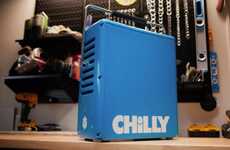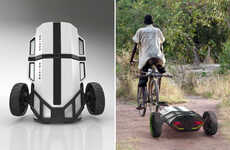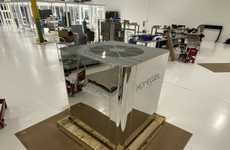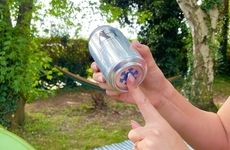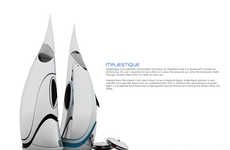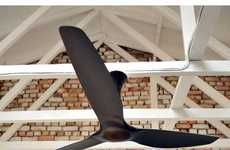
Thermoacoustics Are Sounds that Make Shivers
Katie Cordrey — December 17, 2008 — Eco
References: acs.psu.edu & coolsound.us
Equipped with a loudspeaker and a canister of helium, a patented prototype “thermoacoustic chiller” has been demonstrated as a viable means of refrigeration. Using the principals of a Sterling engine, sound waves from the speaker cause expansion and compression (heating and cooling) of harmless helium gas. The resulting chill can be used in refrigeration. The promise is that HFCs (hydrofluorocarbons) used in current technology can be eliminated. Villain HFCs are thousands of times more destructive to the atmosphere than even carbon dioxide.
That’s great news!
What could be more amazing than cooling with sound?
Well, Ben & Jerry’s, an admittedly liberal bunch, and the U.S. Navy, not so liberal, are BOTH supporting project research.
There may be hope for us yet!
There’s a spiffy little video for RealPlayer or QuickTime at SciencCentral.
To educate the public Ben & Jerry’s has placed a viewer-friendly video that explains thermoacoustics on their site.
If you’d like to see a thermoacoustic experiment in process, check out the You Tube video above.
Photos used with permission: Dr. Matthew E. Poese, research engineer; Dr. Steven Garrett, professor of acoustics at Penn State and thermoacoustic chiller team head; and research engineer/co-inventor Robert Smith.
Photo Credit: Penn State University, Greg Greico
That’s great news!
What could be more amazing than cooling with sound?
Well, Ben & Jerry’s, an admittedly liberal bunch, and the U.S. Navy, not so liberal, are BOTH supporting project research.
There may be hope for us yet!
There’s a spiffy little video for RealPlayer or QuickTime at SciencCentral.
To educate the public Ben & Jerry’s has placed a viewer-friendly video that explains thermoacoustics on their site.
If you’d like to see a thermoacoustic experiment in process, check out the You Tube video above.
Photos used with permission: Dr. Matthew E. Poese, research engineer; Dr. Steven Garrett, professor of acoustics at Penn State and thermoacoustic chiller team head; and research engineer/co-inventor Robert Smith.
Photo Credit: Penn State University, Greg Greico
Trend Themes
1. Thermoacoustic Refrigeration - Disruptive innovation opportunity: Developing more efficient and eco-friendly refrigeration technology by using thermoacoustics to eliminate harmful HFCs.
2. Sound-based Cooling - Disruptive innovation opportunity: Exploring the potential of using sound waves to create cooling effects as an alternative to traditional methods.
3. Collaborative Research - Disruptive innovation opportunity: Encouraging partnerships between businesses and institutions to support research and development in new and sustainable cooling technologies.
Industry Implications
1. Refrigeration - Disruptive innovation opportunity: Innovating and transforming the refrigeration industry by adopting Thermoacoustic Refrigeration technology.
2. Environmental Technology - Disruptive innovation opportunity: Leveraging sound-based cooling as a sustainable solution in the environmental technology industry.
3. Research and Development - Disruptive innovation opportunity: Encouraging collaboration between academia and industry for advancing sound-based cooling technologies in the research and development sector.
3.2
Score
Popularity
Activity
Freshness



